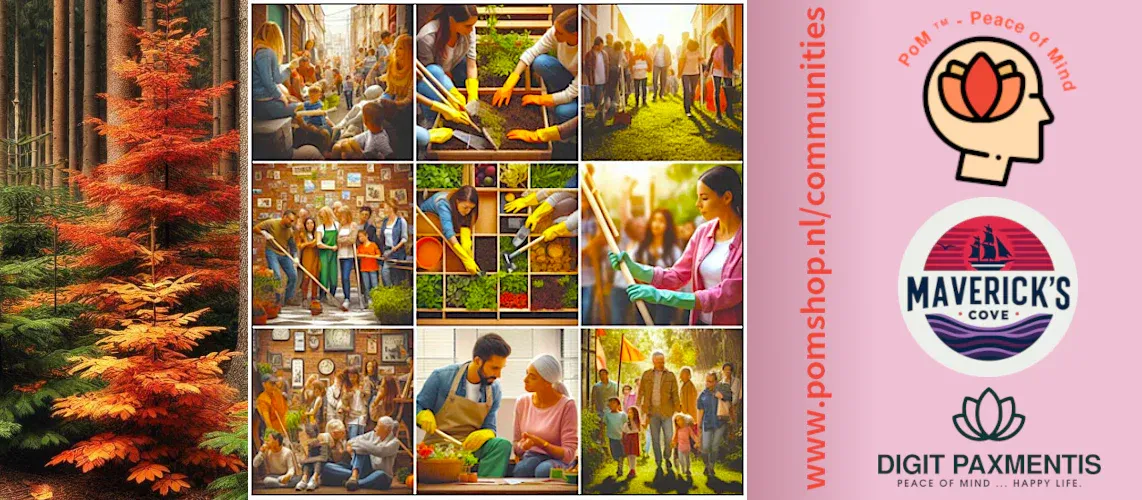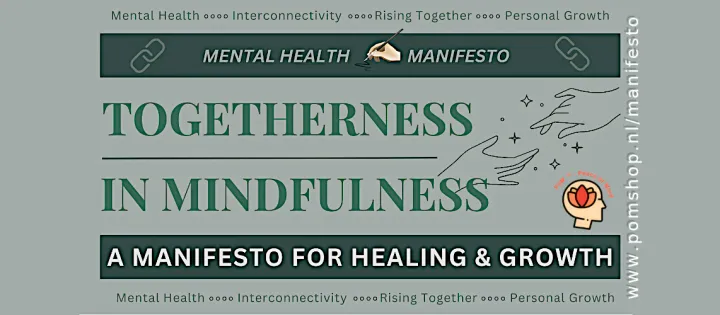Facts: The Nexus of Community, Environment, and Well-being ...

How Relevant Are Healthy Communities and Peaceful Neighborhoods for Mental and Physical Well-Being?
DigitPaxM-06122024. -At PoM - Peace of Mind ... Happy Life! we've long believed in the power of community.

- From the earliest days of human settlements to the bustling neighborhoods of today, strong social connections and a sense of belonging have been fundamental to our well-being.
That's why we're thrilled to introduce our brand new Yard Shield Collection, designed specifically to foster healthy, happy communities and peaceful neighborhoods. Its the start of PoM's Initiative Y2Y (From Yard to Yard) movement.
This essay will explore the profound impact of healthy communities and peaceful neighborhoods on individual mental and physical well-being, and we examine the relevance of such environments, tracing their importance from historical antecedents to modern-day contexts, and considers their future in a globalized world.
Historical and Anthropological Perspectives: The Evolution of Human Settlements
The "concept of community" has been a cornerstone of human existence for millennia. From the earliest hunter-gatherer tribes to the bustling metropolises of today, people have always sought connection and belonging.
The origins of community can be traced back to the transition from nomadic hunter-gatherer societies to settled agricultural communities. Human beings have historically gravitated toward communal living, a trend that can be traced back to the transition from hunter-gatherer societies to agrarian communities approximately 12,000 years ago.
This shift necessitated cooperation and division of labor, leading to the formation of cohesive social groups. Villages and towns emerged as centers of trade, cultural exchange, and mutual support. The formation of villages and towns marked a significant evolutionary step, driven primarily by practical needs such as food security, defense, and social cohesion.
According to anthropologists, this shift allowed for the development of more complex social structures and collective practices, including shared rituals, division of labor, and mutual aid, which are foundational elements of what we now consider healthy communities .
Communities and Psychological Health

Historically, communities often served as protective havens, shielding their members from external threats.
In agrarian societies, the interdependence among individuals within a community was not only a means of survival but also a significant factor in mental well-being. Social bonds formed through cooperative efforts in farming, building, and maintaining communal spaces created a sense of belonging and shared purpose, which are essential for psychological health.
Additionally, communal rituals, celebrations, and shared experiences fostered a strong sense of belonging and identity.
These early communities laid the groundwork for modern understandings of social support networks, which are now recognized as critical determinants of mental health.
How Relevant Are Healthy Communities and Peaceful Neighborhoods for Mental and Physical Well-Being?
The relationship between human well-being and the environments in which we live has been a subject of scholarly inquiry across various disciplines, including psychology, sociology, anthropology, and urban studies. The significance of healthy communities and peaceful neighborhoods extends far beyond mere comfort or convenience; these environments are crucial for fostering both mental and physical health.
The Benefits of Healthy Communities in detail:
- Social Support: Communities offer a network of individuals who provide emotional support, companionship, and assistance in times of need. This social support has been shown to have a significant positive impact on mental health.
- Sense of Belonging: Being part of a community can contribute to a strong sense of identity and belonging. This can enhance self-esteem and reduce feelings of loneliness and isolation.
- Community Engagement: Active participation in community activities can promote a sense of purpose and fulfillment. It can also provide opportunities for physical activity and social interaction.
- Shared Values: Communities often share common values and beliefs, which can create a sense of cohesion and trust. These shared values can foster a supportive and inclusive environment.
- Environmental Benefits: Communities can play a vital role in environmental stewardship. Initiatives such as community gardens, recycling programs, and green spaces can contribute to a healthier and more sustainable environment.
The Impact of Social Cohesion on Well-Being

Research consistently shows that social cohesion—defined as the strength of relationships and the sense of solidarity among members of a community—is a significant predictor of both mental and physical health. A study by Berkman and Syme (1979) was one of the first to establish a strong link between social networks and mortality rates, showing that individuals with more robust social ties had significantly lower mortality rates . This finding has been supported by subsequent research, which has demonstrated that social cohesion reduces stress, enhances immune function, and promotes healthier behaviors.
Moreover, social cohesion can mitigate the effects of socio-economic disadvantages. Wilkinson and Pickett (2009), in their influential book The Spirit Level, argue that societies with greater income equality and stronger social networks experience better overall health outcomes, lower levels of violence, and higher levels of trust among residents . This is particularly relevant in urban environments, where economic disparities can exacerbate feelings of alienation and stress.
Peaceful Neighborhoods and Physical Health

The physical health benefits of living in peaceful neighborhoods are well-documented. A peaceful environment reduces exposure to chronic stressors such as violence, noise, and pollution, all of which have been linked to adverse health outcomes. For instance, chronic exposure to noise pollution has been associated with cardiovascular diseases, including hypertension and heart attacks . Similarly, living in areas with high levels of violence increases the risk of mental health disorders, such as depression and anxiety, and contributes to the development of chronic diseases due to the constant activation of the body's stress response .
Furthermore, peaceful neighborhoods often encourage physical activity, which is a cornerstone of good health. Urban planning that includes green spaces, pedestrian-friendly streets, and recreational areas promotes regular exercise, which is vital for preventing obesity, diabetes, and other lifestyle-related conditions . The concept of "active design" in urban planning is gaining traction as cities around the world recognize the need to create environments that encourage physical activity as a means of improving public health.
The Role of Cultural and Social Practices

Different cultures have developed unique mechanisms to foster healthy communities and peaceful neighborhoods. For instance, the concept of "koinonia" in ancient Greek society emphasized communal living and shared resources, which helped to build strong social ties and a sense of mutual responsibility . Similarly, the tradition of gotong royong in Indonesia, which involves collective community work, fosters social cohesion and ensures that communal spaces are well-maintained .
In more modern contexts, the rise of intentional communities and eco-villages reflects a growing desire to create environments that prioritize social cohesion and environmental sustainability.
Challenges and Opportunities in the Modern World
The modern world presents both challenges and opportunities for community-building. Globalization, urbanization, and the rise of technology have transformed the way we live and interact. While these changes can bring about new connections and opportunities, they can also lead to feelings of isolation and alienation.
To address these challenges, it is important to foster a sense of community at both the local and global levels. This can involve supporting community-based organizations, promoting social inclusion, and utilizing technology to connect people from diverse backgrounds.
The Role of Technology
While technology can sometimes contribute to social isolation, it can also be a powerful tool for community-building. In the 21st century Online platforms and social media can facilitate communication, collaboration, and the sharing of resources among community members. For example, neighborhood-based online forums can be used to organize community events, coordinate volunteer efforts, and address local issues.
However, it is essential to recognize the potential downsides of technology. Excessive screen time and social media addiction can negatively impact mental health. Therefore, it is crucial to strike a balance between digital and face-to-face interactions.
Monastic Communities: A Historical Example of Peaceful Living
These religious communities often emphasized communal living, spiritual practices, and self-sufficiency. The secluded nature of monasteries provided a sense of peace and tranquility.
Monastic communities, which emerged in various religious traditions, were often established as sanctuaries from the external world, providing a space where individuals could focus on spiritual growth and communal harmony.
The Rule of Saint Benedict, as a book with 73 rules, was the foundation of St. Benedict monastries for example. These rules emphasized the importance of stability, work, and prayer within the community, which fostered a sense of peace and well-being among the monks.
The benefits of monastic living are supported by modern research, which shows that meditation, communal activities, and a structured daily routine—key aspects of monastic life—can significantly reduce stress and improve mental health . Moreover, the physical isolation of monastic communities often shielded them from the social and political turmoil of the outside world, further contributing to their inhabitants' well-being.
Inequality and Social Justice
Social and economic inequalities can significantly impact access to healthy communities and their benefits. Individuals living in poverty may face challenges in accessing affordable housing, quality education, and healthcare. Additionally, systemic discrimination can limit opportunities for marginalized groups, such as racial minorities and people with disabilities.
To address these inequalities, it is essential to implement policies that promote affordable housing, equitable education, and accessible healthcare. Additionally, efforts to combat discrimination and promote social justice can help create more inclusive and equitable communities.
The Role of Government and Policy
Government policies and interventions play a crucial role in creating and supporting healthy communities. For example, urban planning policies can promote walkable neighborhoods, green spaces, and mixed-use development. Public transportation systems can improve accessibility and reduce reliance on cars.
Moreover, government programs that support community-based initiatives, such as community gardens, youth programs, and neighborhood watch groups, can help foster social cohesion and strengthen community bonds. By investing in community development, governments can contribute to the overall well-being of their citizens.
Case Studies of Successful Community Initiatives
To illustrate the practical applications of the concepts discussed, it is beneficial to examine specific case studies of successful community initiatives. Throughout history, various community models have emerged, each with its own unique characteristics. Some notable examples include:
- Ecovillages: These intentional communities focus on sustainability, environmental stewardship, and community-building. They often incorporate permaculture, renewable energy, and shared living arrangements.
- Hundertwasserhaus: This iconic building in Vienna is known for its organic architecture and emphasis on individual expression. It has become a symbol of community and creativity.
- Auroville (City of Dawn): This experimental city in India is a notable example of a community built from the ground up with the intention of fostering education, peace, unity and cultural diversity, and sustainable living and inddividual spiritual progress.
Despite facing challenges, such as resource management and cultural integration, Auroville serves as a model for how intentional design can contribute to the well-being of its inhabitants . - Transition Towns movement: Originated in Totnes, England, it has inspired communities around the world to become more self-sufficient and resilient. By promoting local food production, renewable energy, and community-led initiatives, Transition Towns have demonstrated the positive impact of community-based approaches on both environmental sustainability and social well-being.
- Neighborhood of Ladd's Addition (Portland, Oregon): This community has been praised for its walkable streets, green spaces, and strong sense of community. The neighborhood's design promotes social interaction and physical activity, contributing to the health and happiness of its residents.
Challenges and Failures in Community Building
While many communities have thrived, others have faced significant challenges. Utopian projects, such as New Harmony in the United States and the Fourierist Phalansteries in France, ultimately failed due to internal conflicts, economic difficulties, and the impracticality of their ideals .
These failures highlight the importance of balancing idealism with pragmatism in community building. Successful communities typically have strong governance structures, clear economic plans, and mechanisms for conflict resolution, all of which are essential for maintaining peace and well-being.
The Future of Communities in a Globalized World

As we move further into the 21st century, the concept of community is being reshaped by globalization, digital communication, and increased mobility. The rise of online communities and social networks presents both opportunities and challenges for traditional notions of community. While these digital platforms can enhance social connections and provide support networks, they also pose risks, such as social isolation and the spread of misinformation, which can negatively impact mental health .
Moreover, the increasing pace of urbanization and the development of mega-cities, such as "The Line" as a "cognitive city" in Saudi Arabia being built by more than 140,000 workers, present new challenges for creating healthy and peaceful communities.
Such large-scale urban projects aim to integrate sustainable living with high-density populations, but they must also address issues related to social cohesion, economic inequality, and environmental sustainability if they are to succeed in fostering well-being.
Conclusion
The relevance of healthy communities and peaceful neighborhoods for mental and physical well-being is profound and multifaceted. From the earliest agrarian societies to modern-day intentional communities, the benefits of living in a cohesive, peaceful environment are well-documented and supported by a wide range of scientific research. As we look to the future, it is essential to continue exploring and implementing strategies that promote social cohesion, environmental sustainability, and peaceful living in both urban and rural settings.
By doing so, we can ensure that individuals of all ages, genders, and cultural backgrounds can enjoy the mental and physical health benefits that come from living in a supportive community.
Healthy communities and peaceful neighborhoods play a crucial role in promoting individual well-being. - By providing social support, a sense of belonging, and opportunities for engagement, communities can contribute to mental and physical health. As we navigate the complexities of the modern world, it is essential to prioritize community-building and create environments that foster connection, cooperation, and a sense of shared purpose.
Invest in Your Community, Invest in Well-being!
Imagine your neighborhood transformed. Vibrant yard signs reflecting the unique personalities of your residents, sparking conversations, and fostering a sense of connection. With PoM's new Yard Shield Collection, you can be a part of creating this positive change.
Shop our mindfluness collection today and let your yard shield become a symbol of a thriving, happy community!
____________________________________________
References ...
1. Diamond, J. (1997). Guns, Germs, and Steel: The Fates of Human Societies. W. W. Norton & Company.
2. Berkman, L. F., & Syme, S. L. (1979). Social networks, host resistance, and mortality: A nine-year follow-up study of Alameda County residents. American Journal of Epidemiology, 109(2), 186-204.
3. Wilkinson, R., & Pickett, K. (2009). The Spirit Level: Why More Equal Societies Almost Always Do Better. Allen Lane.
4. World Health Organization. (2017). Noise guidelines for Europe. Regional Office for Europe.
5. Wilson, E. O. (2012). The Social Conquest of Earth. W. W. Norton & Company.
6. Tönnies, F. (2001). Community and Society (C. P. Loomis, Trans.). Dover Publications. (Original work published 1887)
7. Urry, J. (2000). Sociology Beyond Societies: Mobilities for the Twenty-First Century. Routledge.
8. Etzioni, A. (1996). The Responsive Community: A Communitarian Perspective. American Sociological Review, 61(1), 1-11.
9. Alexander, C., Ishikawa, S., & Silverstein, M. (1977). A Pattern Language: Towns, Buildings, Construction. Oxford University Press.
10. Trzebiatowska, M., & Bruce, S. (2012). Why Are Women More Religious than Men?. Oxford University Press.
+++




Comments ()